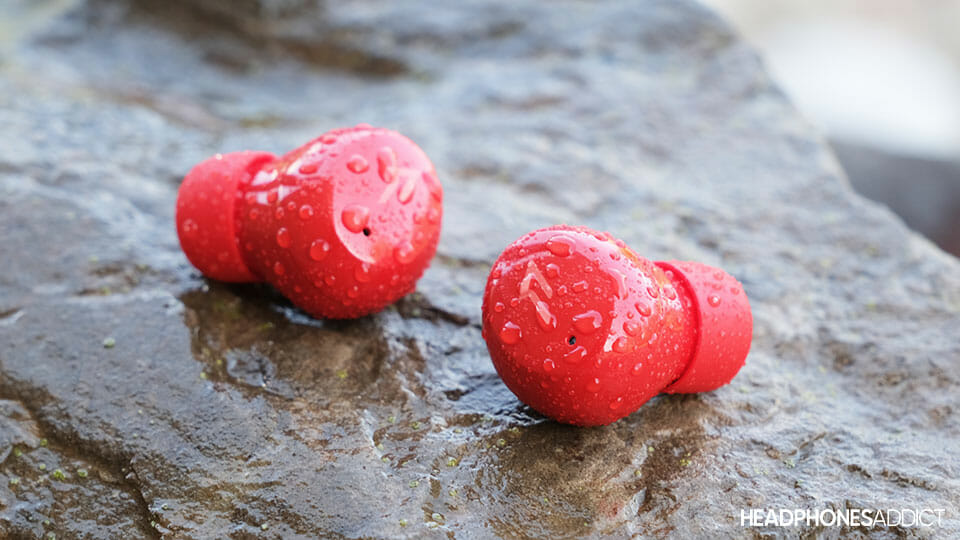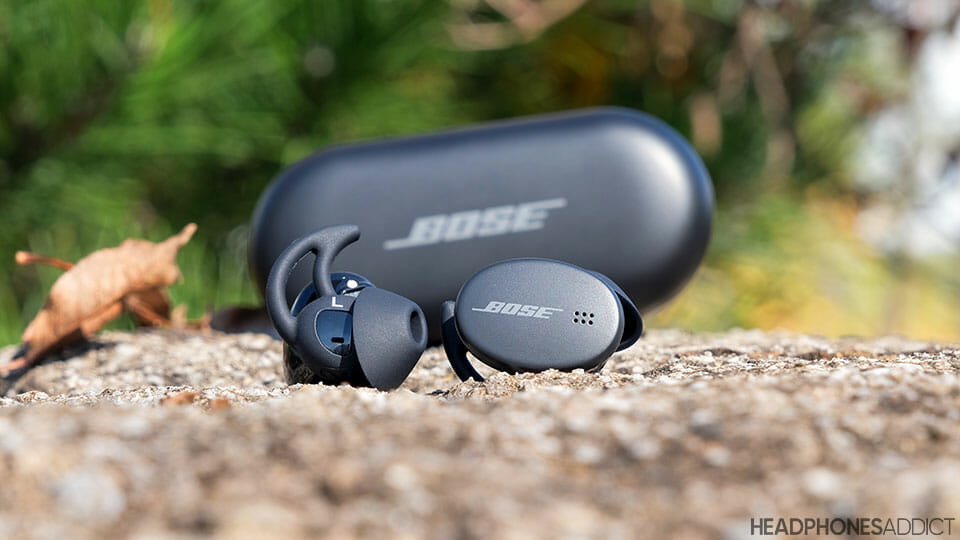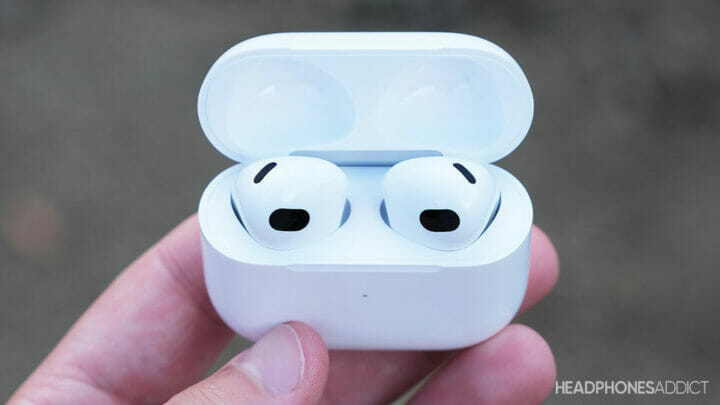Here’s how waterproof headphones differ from water-resistant, water-repellent, and weatherproof.
Please read carefully so you don’t ruin your earbuds by exposing them to too much water.

Here’s a table of comparing water-resistant vs waterproof headphones:
| Activity | Waterproof headphones | Water-resistant headphones |
|---|---|---|
| Sweat | Safe | Safe |
| Light rain | Safe | Safe |
| Showering | Safe | Safe (only IPX5) |
| Swimming | Safe | Not safe |
| Submerge underwater | Safe | Not safe |
What Are Waterproof Earbuds and Headphones
Waterproof earbuds and headphones are fully enclosed and completely protected against submersion in water. They’re rated at IPX7 and higher. They’re protected by a special hydrophobic coating that blocks water intrusion.

They feature sealed ports and casing openings that withstand submersion in water. This is the highest level of water protection.
Most of the top workout earbuds are fully waterproof, so you can wash them under tap water after use.
Activities you can do with waterproof headphones
Waterproof headphones are safe against sweat, rain, showering, swimming, bathing, submerging in water for a short duration, and all types of water sports.
They’re not suitable for diving because the water protection of waterproof earbuds isn’t strong enough at higher depths. You can only submerge them up to a depth of 3 ft (1m).
Also, over time and with use, the protective coating becomes thinner and loses its waterproofing properties. It’s not uncommon, even for fully waterproof earbuds, to stop working after a couple of years.
- Check the details of the warranty policy for your headphones
What Are Water-Resistant Earbuds and Headphones
Water-resistant earbuds and headphones are protected against water but to a lower degree. They’re rated from IPX4 to IPX6. Different levels of water-resistant headphones can withstand different levels of water. It’s determined by their IPX rating.

Activities you can do with water-resistant headphones
IPX4 water-resistant headphones are protected against sweat and light rain, but you can’t wash them under tap water or use them in a shower.
IPX5-6 water-resistant headphones are also protected against a higher pressure of water. You can wash them under a tap and use them for showering, but you can’t submerge them in water.
P.S. IPX5 is right at the limit of protection for showering. If you have IPX5-rated headphones, it’s best not to use them for showering too often.
What Are Water-Repellent Headphones
Water-repellent headphones are often another name for water-resistant headphones with a protective coating that repels water. A thin layer of hydrophobic coating makes water bead up and prevents water intrusion.
But it doesn’t tell the level of protection. To know what level of protection your water-repellent headphones have, check their IPX rating.
The difference between water-repellent vs waterproof/resistant
Water-repellent headphones have a thin layer of waterproofing material that makes water bead up and roll off the surface instead of absorbing into the material.
Water-repelling coatings are typically made from silicones, epoxy, and other hydrophobic materials that repel water.
- Waterproof coatings are thicker and stronger, so they can prevent liquid intrusion under water pressure. Waterproof earbuds are suitable for exposure to heavy moisture.
- Water-repellent headphones are suitable for occasional and light moisture.

Water wicking headphones
Water-wicking headphones is another name for water-repellent headphones. The “wicking” describes the effect of a hydrophobic coating. It draws water away from electronic components, similar to the water-repelling effect.
So, to find out the water protection of your headphones, check for their IPX rating. If it’s not given by the manufacturer, assume a very low level of protection (IPX4 and lower).
Weatherproof headphones
Weatherproof headphones are protected against different weather conditions like heavy rain, air humidity, dust, and extreme temperatures. Typically, they’re more rugged and durable than standard headphones. But check their IP (IPX) rating for the exact dust and water-protection level.

Rainproof headphones
Rainproof headphones are specifically protected against rain, and outside moisture, so they’re safe to use during bad weather. They often have a higher level of water protection than weatherproof headphones. But check first.
Usually, this is just a fancy way of saying the product has some level of water protection.
Check the IPX rating if available, or assume a low rating of IPX4 or lower.
FAQs
Are Bose SoundSport waterproof?
Bose SoundSport in-ear headphones are not waterproof, according to Bose. Instead, they’re water-resistant and protected against sweat and splashing water. But you can’t submerge them or use them for showering.
Can you shower with water-resistant earbuds?
Yes, you can shower with water-resistant earbuds if they have IPX5 or higher water protection. IPX5 protection is rated to be safe against a 15-minute jet of water, so a light, low-pressure shower spray is safe.
Conclusion
There’s a lot of ambiguity between the meaning of the term waterproof and water-resistant earbuds. It’s wrong to think they’re both the same.
Many people break their headphones, assuming they’re safe from heavier water exposure. To avoid problems yourself, check the IPX rating of your headphones and what it means before seriously exposing them to water.
If you’re looking for fully protected headphones, check the best waterproof wireless headphones, and the best headphones for swimming, which you can use for shallow diving.

Matija Ferjan is a seasoned audio enthusiast reviewing headphones since 2015. He has personally tested hundreds of headphones and earbuds. He’s an active member of the Headphone Audio community and a true nitpicker, always looking for the “best-value-for-money” headphones.



